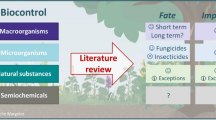Abstract
Wood preservation is one of the most effective methods to prevent damage caused by termites. Sodium fluoride (NaF) is a well-known fungicide for preventing decay in timber due to its excellent diffusion in wood. In this study, the toxicity of NaF to the termites Reticulitermes flaviceps and its potential leachability as wood preservative were assessed. While termites were in contact with NaF-treated filter paper in a Petri dish for nine days, termites were found completely dead while the papers were treated by NaF at concentration of 0.5 % (wt/wt) or above. Wood blocks of Pinus massoniana were treated with five different concentrations of NaF (0.1, 0.25, 0.5, 1 and 2 %) respectively, and then exposed to a non-soil-contact field leaching experiment. After 4 weeks, retention levels of NaF in the wood blocks dropped from 0.075–0.834 % to 0.057–0.284 %. A choice test, in which NaF-treated and untreated wood blocks were exposed to the termites R. flaviceps was conducted. The results showed NaF, even at retention of 0.057 % (wt/wt), could significantly inhibit termite feeding in the treated blocks. The results suggest that NaF is a suitable wood preservative with anti-feedant activity against termites.



Similar content being viewed by others
References
Baechler RH (1953) Effects of treating variables on absorption and distribution of chemicals in pine posts treated by double diffusion. In: Forest Products Society (ed), Seventh annual national meeting proceedings, Memphis, pp 170–176
Baechler RH, Roth HG (1956) Laboratory leaching and decay tests on pine and oak blocks treated with several preservative salts. Proc Am Wood Preserv Assoc 52:24–33
Becker G (1973) Fluorine compounds for wood preservation. J Inst Wood Sci 6:51–62
Becker G (1974) Aspects, results and trends in wood preservation, an interdisciplinary science. Wood Sci Technol 8:163–183
Becker G (1976) Treatment of wood by diffusion of salts. J Inst Wood Sci 7:30–46
Cabrera Y, Morrell JJ (2009) Effect of wood moisture content and rod dosage on boron or fluoride movement through Douglas-fir heartwood. For Prod J 59:93–96
Chen H, Rhatigan R, Morrell JJ (2003) A rapid method for fluoride analysis of treated wood. For Prod J 53:43–45
Fahlstrom GB (1964) Threshold values for wood preservatives. For Prod J 14:529–530
Freitag C, Morrell JJ (2005) Development of threshold values for boron and fluoride in non-soil contact applications. For Prod J 55:97–101
Furuno T, Lin L, Katoh S (2003) Leachability, decay, and termite resistance of wood treated with metaborates. J Wood Sci 49:344–348
Gerber SB, Finn KV (2007) Using SPSS for Windows: data analysis and graphics. Springer, New York
Grace JK (1998) Resistance of pine treated with chromated copper arsenate to the Formosan subterranean termite. For Prod J 48:79–82
Hadi YS, Westin M, Rasyid E (2005) Resistance of furfurylated wood to termite attack. For Prod J 55:85–92
Johanson R, Howick CD (1975) Copper-fluorine-boron diffusion wood preservative III. Termiticidal effect of fluorine, boron and F-B complex. Holzforschung 29:25–29
Li HB, Xu XR (1999) Separation and determination of fluoride in plant samples. Talanta 48:57–62
Mao LX, Henderson G, Scherer CW (2011) Toxicity of seven termiticides on the Formosan and eastern subterranean termites. J Econ Entomol 104:1002–1008
Militz H, Schaffert S, Peters BC, Fitzgerald CJ (2011) Termite resistance of DMDHEU-treated wood. Wood Sci Technol 45:547–557
Morrell JJ, Love CS (1995) Fluoride movement through Douglas-fir and hem-fir lumber following dipping in potassium/ammonium bifluoride. IRG/WP/95-40040. International Research Group on Wood Preservation, Stockholm
Morrell JJ, Freitag CM, Chen H (2005) Sequential treatments with fluoride and copper: effects of solution concentration and dipping time on treatment. For Prod J 55:57–62
Pan CY, Dai QF, Zhu YD (2011) Barrier and transfer properties of termiticides against the subterranean termite Reticulitermes flaviceps (Isoptera: Rhinotermitidae). Sociobiology 57:659–668
Richards CA (1924) The comparative resistance of 17 species of wood-destroying fungi to sodium fluoride. Proc Am Wood Preserv Assoc 12:37–44
Rowell RM (2006) Acetylation of wood: a journey from analytical technique to commercial reality. For Prod J 56:4–12
Schultz TP, Nicholas DD, Preston AF (2007) A brief review of the past, present and future of wood preservation. Pest Manag Sci 63:784–788
Su NY, Scheffrahn RH (1992) Penetration of sized-particle barriers by field populations of subterranean termites (Isoptera: Rhinotermitidae). J Econ Entomol 85:2275–2278
Su NY, Scheffrahn RH, Ban PM (1993) Barrier efficacy of pyrethroid and organophosphate formulations against subterranean termites (Isoptera: Rhinotermitidae). J Econ Entomol 86:772–776
Su NY, Tokoro M, Scheffrahn RH (1994) Estimating oral toxicity of slow-acting toxicants against subterranean termites (Isoptera: Rhinotermitidae). J Econ Entomol 87:398–401
Usta M, Ustaomer D, Kartal SN, Ondaral S (2009) Termite resistance of MDF panels treated with various boron compounds. Int J Mol Sci 10:2789–2797
Wada H, Mori H, Nakagawa G (1985) Spectrophotometric determination of fluoride with lanthanum/alizarin complexone by flow injection analysis. Anal Chim Acta 172:297–302
Acknowledgments
The authors want to thank for the financial support of Zhejiang Provincial Natural Science Foundation of China (Grant No. Y3110272) and the Development Fund of Zhejiang A&F University (Grant No. 2010FR024 and Grant No. 2012FR087).
Author information
Authors and Affiliations
Corresponding author
Rights and permissions
About this article
Cite this article
Pan, C., Ruan, G., Chen, H. et al. Toxicity of sodium fluoride to subterranean termites and leachability as a wood preservative. Eur. J. Wood Prod. 73, 97–102 (2015). https://doi.org/10.1007/s00107-014-0849-x
Received:
Published:
Issue Date:
DOI: https://doi.org/10.1007/s00107-014-0849-x




